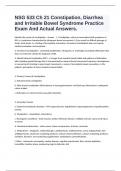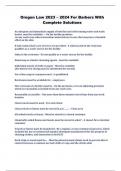NSG 533 Ch 21 Constipation, Diarrhea
and Irritable Bowel Syndrome Practice
Exam And Actual Answers.
Identify the causes of constipation - Answer 1. Constipation, when not associated with symptoms of
IBS, is a syndrome characterized by infrequent bowel movements (<3 per week) or difficult passage of
stools, hard stools, or a feeling of incomplete evacuation. Occasional constipation does not require
medical evaluation and treatment.
2. Functional Constipation - constantly problematic, infrequent, or seemingly incomplete defecation that
does not meet the criteria for diagnosis of IBS.
3. Opioid Induced constipation (OIC) - a change from baseline bowel habits and patterns of defecation
after initiating opioid therapy that is characterized by reduced bowel movement frequency, development
or worsening of straining to pass bowel movements, a sense of incomplete bowel evacuation, or the
patient's perception of stress related to bowel habits.
4. Primary Causes of Constipation
a. Normal-transit constipation
b. Slow-transit constipation (disturbances of neurogastroentero- and brain-gut interactions, inadequate
caloric intake)
c. Defecatory or colonic/rectal evacuation disorders
5. Secondary Causes
a. Endocrine/metabolic disorders - DM, hypercalcemia, hypokalemia, hypomagnesemia, hypothyroidism,
uremia.
b. Myopathies - amyloidosis, sclerodoma
c. Neurogenic Conditions - brain trauma, stroke, Parkinson disease, multiple sclerosis, spinal cord injury
or tumor
d. Mechanical obstruction - colon cancer, lesion compression, stricture, rectocele
e. Medications - Analgesics, anticholinergics, antidiarrheals, antihistamines, some antipsychotics and
antidepressants, aluminum containing products, calcium channel blockers, calcium containing products,
clonidine, diuretics, iron-containing supplements, ondansetron, phenothiazines
f. Other - autonomic neuropathy, cardiac disease, cognitive impairment, diet, volume depletion,
immobility, laxative abuse, postponing urge to defecate, deli
, Compare the features of constipation with those of irritable bowel syndrome with constipation (IBS-C) -
Answer
Recommend lifestyle modifications and pharmacotherapy for treatment of constipation - Answer
Lifestyle modifications -
a. Scheduling routine bathroom time
b. Elevate feet on a stool
c. Increased dietary fiber or fiber supplementation (20-30 g/day) will improve NTC but not STC or drug-
induced constipation. High fiber foods include beans, whole grains, bran cereals, fresh fruits, and
vegetables such as asparagus, Brussels, cabbage, and carrots. Soluble - can be dissolved in water vs non-
soluble fiber - cannot be dissolved in water.
d. adequate fluid intake -men 19 and older = 3.7 L/day and women 19 and older 2.7 L/day.
e. Biofeedback-aided pelvic floor training
f. Surgical intervention - colectomy and ileorectal anastomosis may be considered in patients with STC
Pharmacologic -
1. Oral laxatives are the primary pharmacologic intervention for relief of most constipation, including
OIC.
2. Additional treatment for OIC is Calcium Channel activator and peripherally acting u-opioid receptor
antagonists.
OTC agents that cause softening of feces in 1-3 days (see 21-2)
1. Bulk-forming agent/osmotic laxatives - Methylcellulose, Polycarbophil, Psyllium
2. Emollients - Docusate Sodium, Docusate Calcium, Docusate potassium, lactulose
3. Sorbitol
4. Mineral Oil
OTC agents that result in soft semi-fluid stool in 6-12 hours
1. Bisocosyl (oral)
2. Senna





